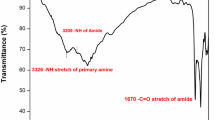Abstract
A novel aromatic chiral dicarboxylic acid, 5-[4-(2-tetrabromophthalimidylpropanoylamino)benzoylamino]isophthalic acid was synthesized in three steps in high yield and purity starting from tetrabromophthalic anhydride and l-alanine. A series of new soluble, thermally stable and optically active polyamides (PA)s having pendent tetrabromophthalimide, flexible asymmetrical and benzamide groups with flame retardancy properties have been successfully prepared using triphenyl phosphite/pyridine in the presence of calcium chloride and N-methyl-2-pyrrolidone (NMP). The resulting new polymers were obtained in good yields, inherent viscosities ranging between 0.36 and 0.63 dL g−1 and were characterized with FT-IR, 1H NMR, specific rotation and thermogravimetric analysis techniques. Bulky pendent groups of the polymer chains disturb interchain and intrachain interactions and make these polymers readily soluble in various solvents, such as NMP, N,N-dimethylacetamide, dimethyl sulfoxide, and N,N-dimethylformamide. The resulting PAs were thermally stable, with 10 % weight loss recorded at 432 and 478 °C in the nitrogen atmosphere. In addition, due to existence of chiral center and optical activity of these polymers, they have potential to be utilized as chiral stationary phase in chromatography technique for the separation of racemic mixtures.








Similar content being viewed by others
References
Shen J, Okamoto Y (2015) Efficient separation of enantiomers using stereoregular chiral polymers. Chem Rev. doi:10.1021/acs.chemrev.5b00317
Liu P, Zhang X, Xu W, Guo C, Wang S (2012) Electrochemical sensor for the determination of brucine in human serum based on molecularly imprinted poly-o-phenylenediamine/SWNTs composite film. Sens Actuators, B 163:84–89
Anger E, Iida H, Yamaguchi T, Hayashi K, Kumano D, Crassous J, Vanthuyne N, Rousselc C, Yashima E (2014) Synthesis and chiral recognition ability of helical polyacetylenes bearing helicene pendants. Polym Chem 5:4909–4914
Zhang J, Shi C, Ji T, Wu G, Kou K (2014) Preparation and microwave absorbing characteristics of multi-walled carbon nanotube/chiral-polyaniline composites. Open J Polym Chem 4:62–72
Ohsawa S, Sakurai SI, Nagai K, Maeda K, Kumaki J, Yashima E (2012) Amplification of macromolecular helicity of dynamic helical poly(phenylacetylene)s bearing non-racemic alanine pendants in dilute solution, liquid crystal and two-dimensional crystal. Polym J 44:42–50
Ouyang QY, Chen YJ, Li CY (2012) The fabrication and enhanced nonlinear optical properties of electrostatic self-assembled film containing water-soluble chiral polymers. Mater Chem Phys 134:80–86
Qiu F, Liu J, Cao G, Guan Y, Shen Q, Yang D, Guo Q (2013) Synthesis, thermo-optic properties and polymeric thermooptic switch based on novel optically active polyurethane (urea). Soft Mater 11:233–243
Algieri C, Drioli E, Guzzo L, Donato L (2014) Bio-mimetic sensors based on molecularly imprinted membranes. Sensors 14:13863–13912
Itsuno S, Paul DK, Salam MA, Haraguchi N (2010) Main-chain ionic chiral polymers: synthesis of optically active quaternary ammonium sulfonate polymers and their application in asymmetric catalysis. J Am Chem Soc 132:2864–2865
Mallakpour S, Zadehnazari A (2011) Advances in synthetic optically active condensation polymers—a review. Express Polym Lett 5(2):142–181
U.S. EPA (2012). Certain polybrominated diphenylethers; significant new use rule and test rule. 77 FR 19862
Mittal V, Banerjee S, Maji S (2011) High-performance processable aromatic polyamides. Wiley, New York
Garcia JM, Garcia FC, Serna F, de la Pena JL (2010) High-performance aromatic polyamides. Prog Polym Sci 35:623–686
More AS, Pasale SK, Wadgaonkar PP (2010) Synthesis and characterization of polyamides containing pendant pentadecyl chains. Eur Polym J 46:557–567
Gooch JW (2011) Encyclopedic dictionary of polymers. Springer, Atlanta
Damaceanu MD, Rusu RD, Nicolescu A, Bruma M, Rusanov AL (2011) Organosoluble asymmetric aromatic polyamides bearing pendent phenoxy groups. Polym Int 60:1248–1258
Bera D, Bandyopadhyay P, Ghosh S, Banerjee S, Padmanabhan V (2015) Highly gas permeable aromatic polyamides containing adamantane substituted triphenylamine. J Membr Sci 474:20–31
Mallakpour S, Rafiee Z (2011) New developments in polymer science and technology using combination of ionic liquids and microwave irradiation. Prog Polym Sci 36:1754–1765
Higashi F, Yokote S, Murakawa T (2004) New polyamidation through the activation of amino groups with phenyl dichlorophosphite in pyridine. J Polym Sci, Part A: Polym Chem 42:4126–4131
Higashi F in: Mijs WJ (Ed.) (1992) New methods for polymer synthesis. Plenum Press, New York, Chapter 7
Van Krevelen DW, Hoftyzer PJ (1976) Properties of polymers, 3rd edn. Elsevier, Amsterdam
Horrocks AR, Price D (2001) Fire retardant materials. Woodhead Publishing Ltd, Cambridge
Goncalves ES, Poulsen L, Ogilby PR (2007) Mechanism of the temperature-dependent degradation of polyamide 66 films exposed to water. Polym Degrad Stab 92:1977–1985
Author information
Authors and Affiliations
Corresponding author
Rights and permissions
About this article
Cite this article
Rafiee, Z., Mallakpour, S. Synthesis and properties of novel brominated chiral polyamides derived from 5-[4-(2-tetrabromophthalimidylpropanoylamino)benzoylamino]isophthalic acid and aromatic diamines. Polym. Bull. 73, 1951–1964 (2016). https://doi.org/10.1007/s00289-015-1587-x
Received:
Revised:
Accepted:
Published:
Issue Date:
DOI: https://doi.org/10.1007/s00289-015-1587-x



